Portal:Latin America/Featured picture/2006
Today is January 4, 2025, week number 1.
Weeks in 2006
[edit]- Week 23
Portal:Latin America/Featured picture/Week 23, 2006
view -
talk -
history
- Week 24
Portal:Latin America/Featured picture/Week 24, 2006
view -
talk -
history
- Week 25
Portal:Latin America/Featured picture/Week 25, 2006
view -
talk -
history
- Week 26
Portal:Latin America/Featured picture/Week 26, 2006
view -
talk -
history
- Week 27

Tarantulas are long-legged, long-living spiders, whose entire body is covered with short glittery hairs called setae. Tarantulas inhabit tropical to temperate regions, including South America and Central America.
The body of the tarantula pictured above is approximately 2.5 inches (6.2 cm) long. Despite their often scary appearance and reputation, none of the true tarantulas are deadly spiders (spiders having a strong toxin, dangerous to humans), and this particular kind of tarantula is regarded as especially docile.
In the wild, they will consume almost any kind of arthropod, small lizard, or small rodent that they can overpower and immobilize with their venom.
view -
talk -
history
- Week 28

Machu Picchu (Quechua: Old Mountain; sometimes called the "Lost City of the Incas") is a well-preserved pre-Columbian Inca ruin located on a high mountain ridge. Elevation measurements vary depending on whether the data refers to the ruin or the extremity of the mountain, Machu Picchu tourist information reports the elevation as 2,350 m (7,710 ft). Machu Picchu is located above the Urubamba Valley in Peru, about 70 km (44 mi) northwest of Cusco. Forgotten for centuries by the outside world, although not by locals, it was brought back to international attention by Yale archeologist Hiram Bingham who rediscovered it in 1911, and wrote a best-selling work about it.
view -
talk -
history
- Week 29
Portal:Latin America/Featured picture/Week 29, 2006
view -
talk -
history
- Week 30
Portal:Latin America/Featured picture/Week 30, 2006
view -
talk -
history
- Week 31
Portal:Latin America/Featured picture/Week 31, 2006
view -
talk -
history
- Week 32
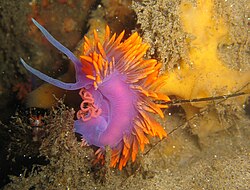
The Spanish shawl (Flabellina iodinea) is a nudibranch native to the North American west coast. It has been reported as far north as British Columbia, Canada and as far south as Punta Asuncion, Baja California Sur, Mexico, and in addition to this in the Gulf of California and the Galapagos Islands. It displays a stunning set of colors, the body being purple, the gills being orange and the rhinophores being scarlet red.
view -
talk -
history
- Week 33

Rano Raraku is a volcanic crater formed of consolidated ash, or tuff, and located on Easter Island, Chile. It is the quarry in which about 95% of the island's known monolithic sculpture (Moai) were carved.
The sides of Rano Raraku crater are high and steep except on the north and northwest, where they are much lower and gently sloping. The interior contains a freshwater lake bordered by reeds called tortora (Scripus sp.). The reeds, once believed to have been carried to the island by explorers from the South American mainland, are now known to have been naturally introduced some 30,000 years ago.
view -
talk -
history
- Week 34
Portal:Latin America/Featured picture/Week 34, 2006
view -
talk -
history
- Week 35
The Southern Patagonia Ice Field is the third biggest extension of continental ice after the Antarctica and Greenland, located at the Southern Patagonic Andes between Chile and Argentina, and part of the Patagonian Ice Sheet.
It extends from parallels 48º20'S to 51º30' for approximately 350 kilometres, and has an area of 16,800 km², of which 14,200 km² belong to Chile, and 2,600 km² to Argentina.
The ice field was first studied in 1943 by aereal photographies made by the United States' Air Force on request of the Chilean government. Later explorations include the expeditions of Federico Reichert and Alberto de Agostini, but the field remains largely unexplored.
view -
talk -
history
- Week 36
The sunflower (Helianthus annuus) is an annual plant in the family Asteraceae, with a large flower head (inflorescence). The stem of the flower can grow up to 3 metres tall, with the flower head reaching 30cm in diameter. The term "sunflower" is also used to refer to all plants of the genus Helianthus, many of which are perennial plants.
Sunflowers are native to the Americas, and were domesticated around 1000 B.C. Francisco Pizarro found the Inca subjects venerating the sunflower as an image of their sun god. Gold images of the flower, as well as seeds, were taken back to Europe early in the 16th century.
view -
talk -
history
- Week 37
Portal:Latin America/Featured picture/Week 37, 2006
view -
talk -
history
- Week 38
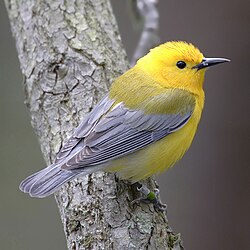
The Prothonotary Warbler (Protonotaria citrea) is a small songbird of the New World warbler family. It is the only member of the genus Protonotaria.
The Prothonotary Warbler is 13 cm long and weighs 12.5 g. It has an olive back with blue-grey wings and tail, yellow underparts, a relatively long pointed bill and black legs. The adult male has a bright orange-yellow head; females and immature birds are duller and have a yellow head.
It breeds in hardwood swamps in southern Canada and the eastern United States, nesting in a cavity, sometimes using old Downy Woodpecker holes. The male often builds several incomplete unused nests in his territory; the female builds the real nest. It winters in the West Indies, Central America and northern South America.
view -
talk -
history
- Week 39

The citrus root weevil (Diaprepes abbreviatus) is a major agricultural pest weevil in several Caribbean countries and the US state of Florida. It is also known as the diaprepes root weevil and the sugarcane rootstock borer weevil. The weevil is found on many plants besides citrus, including sugarcane, tuber-bearing crops such as potatoes, and many ornamental plants.
view -
talk -
history
- Week 40
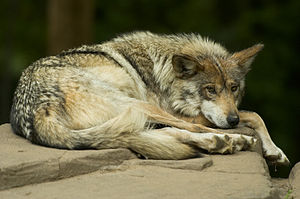
The Mexican Wolf (Canis lupus baileyi) is the rarest, most genetically distinct subspecies of the Gray Wolf in North America. It is also one of the smallest subspecies, reaching an overall length no greater than 135 cm (53 in) and a maximum height of about 80 cm (31 in). Weight ranges from 27-45 kg (60-100 lbs).
view -
talk -
history
- Week 41
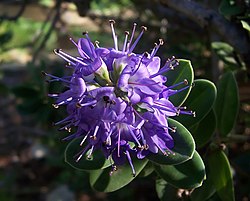
Hebe is a genus of plants native to New Zealand, Australia, Papua New Guinea, Rapa Nui, the Falkland Islands, and South America. There are over 100 species of Hebe, of which 90 occur in New Zealand. Of the 90 present in New Zealand, only H. salicifolia and H. elliptica extend beyond New Zealand, the remainder being endemic. They are named after the Greek goddess of youth, Hebe.
view -
talk -
history
- Week 42
Portal:Latin America/Featured picture/Week 42, 2006
view -
talk -
history
- Week 43

The lynx inhabits the high altitude forests with dense cover of shrubs, reeds and grass. Though the cat hunts only on the ground, it can climb trees and swim. Though it can be found in the northern regions of Scandinavia, it is primarily found in North America and also in pockets in the Himalayas.
view -
talk -
history
- Week 44
Portal:Latin America/Featured picture/Week 44, 2006
view -
talk -
history
- Week 45

The citrus root weevil (Diaprepes abbreviatus) is a major agricultural pest weevil in several Caribbean countries and the US state of Florida. It is also known as the diaprepes root weevil and the sugarcane rootstock borer weevil. The weevil is found on many plants besides citrus, including sugarcane, tuber-bearing crops such as potatoes, and many ornamental plants.
view -
talk -
history
- Week 46
Portal:Latin America/Featured picture/Week 46, 2006
view -
talk -
history
- Week 47
Portal:Latin America/Featured picture/Week 47, 2006
view -
talk -
history
- Week 48
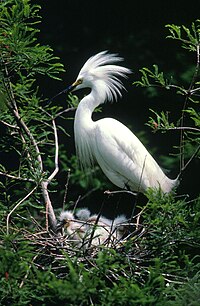
The Snowy Egret is a small white heron. These birds stalk their prey in shallow water, often running or shuffling their feet, flushing prey into view. Snowy egrets may also stand still and wait to ambush prey. Their breeding habitat is large inland and coastal wetlands from the lower Great Lakes and southwestern United States to South America.
view -
talk -
history
- Week 49
Portal:Latin America/Featured picture/Week 49, 2006
view -
talk -
history
- Week 50
Portal:Latin America/Featured picture/Week 50, 2006
view -
talk -
history
- Week 51
Portal:Latin America/Featured picture/Week 51, 2006
view -
talk -
history
- Week 52
Portal:Latin America/Featured picture/Week 52, 2006
view -
talk -
history
